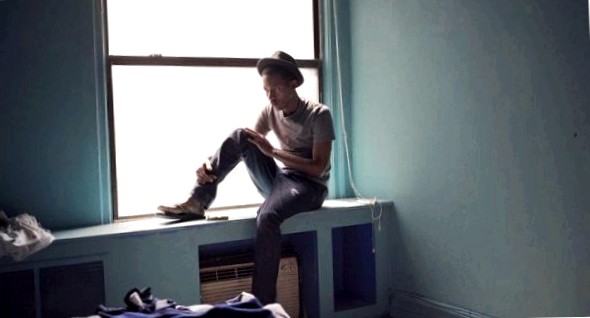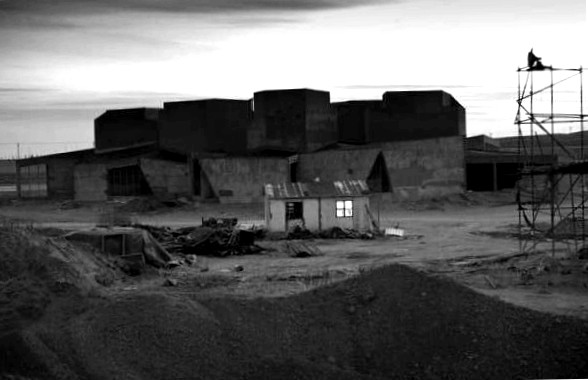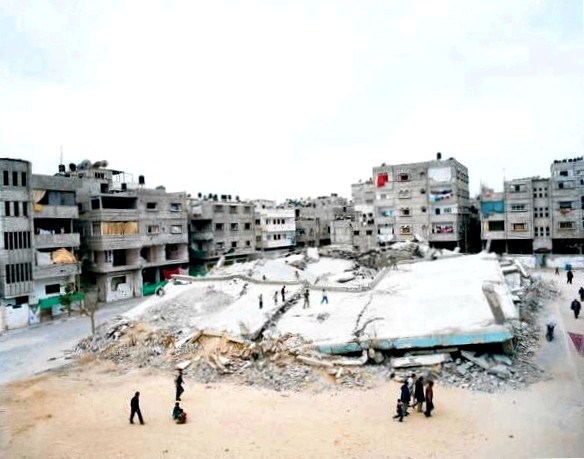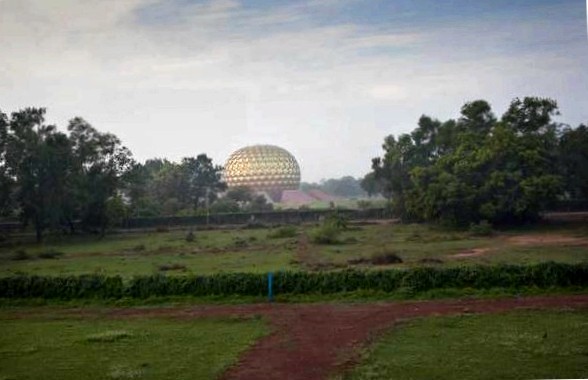
Dawin Meckel: Downtown. © Copyright 2010 Dawin Meckel / Ostkreuz Agency of the photographer, Berlin
The picture of the city in 21. Century oscillates beyond romantic dreams
Every second person lives in the city. And photos are to determine our image from this process. So the new record mark that has reached urbanization in 2008 also occasion for some artistic and photographic inventory.
One of them is currently to be seen in Berlin, in the agency Ostkreuz in the C / O Berlin: the city. From becoming and passing (still up to 4. July). 18 photographers traveled to the city and metropolitan areas around the globe, from Lagos to Las Vegas, from Detroit to Chernobyl.
The show also documents the simultaneous decay of existing citys that will shrink or destroy. Dawin Meckel, for example, Detroit documents as a synonym for the decline of a bust city collected formerly for the future legend.
As a bridge between the cultures, Istanbul has been valid for centuries, metropolis with 15 million inhabitants. The force of urban globalization has released the city in the Bosphorus relentlessly. Capital investors penetrated into the most profitable areas of the city. More and more soil is thrown on the market and the city is subjected to an irreversible process of realignment. Culture and commerce advised in a nearly incompatible position.
Factory owners lay their production to sell the earlier location expensive, strainge are renamed the new spirit accordingly, art and cultural heritage as a business and prestigious business fields redefined. A controversial law allows the "renovation" historical territories. And in fact, the "Master plan" swallows an old, an existing city. Prime Minister Erdogan had explained, he consider it his duty to make Turkey market. The fragile side of globalization: Old Istanbul districts become objects of radical renovation together with abandoned Greek orthodox churches "more attractive" Construction projects.
An Istanbul variant of the Dubai Tower as a highest building of Turkey with a construction volume of fun billion dollars is in conversation. The state authority to develop the housing construction (Toki) predicts the demolition of half (!) of the Istanbul built in construction, around 1.5 million objects in the coming twenty years. Residents of the historic city cores like Sulukule will find far drabs on the new outskirts in expedient concrete buildings.

Thomas Meyer: The Resort. © Copyright 2010 Thomas Meyer / Ostkreuz Agency of Photographers, Berlin
Better City, Better Life? Where city asserts as a life and future room, this is always more frequent against, not politics. "city", This is for many only one word, a desert of concrete and dirt, a pilling of stinking wastewater, adventure resort of real violence. But also the chic skyscraper cities are far from the romance long past metropolises. The turbo stadding has the old as the new building sites on the planet firmly under control. the "Rough city" As a season, as a crucible of the cultures, as a place to live and for commonalities seems irretrievably lost. The Hyperstadt becomes the imaging machine — she himself brings out phantasmagoric images, generating their own future. And the pictures fall from Babylonian.
Century of the city
It is the descent of the city. There below, where the light comes from, life is being buzzed, born, born, lives hedged, hedging in the thousand lives in the straws, the shop, the department stores with their light signs, the inns, animating pubs and castems with their beerdunst and gay bridges. In which trucks and crimes thrive as in huge greenhausern, in which the poison of drinking addiction and all eclaving diseases is spread from body to body.
Hermann Drechsler, file dust. From the diary of a welfare dentor. Berlin 1932
What the Berlin city official in 1932 entrusted here to his diary here corresponded to the impression of the "Coarse city" as the place of failed dreams. The faith in an era of unlimited possibilities, urban progress, technology and rationality had already the I. World War II, poverty, depression, political and social break lines had been pushed; And yet the sketched image of Berlin shows a now almost romantic night side of civilization. Cities such as London, Berlin, New York, but also Tokyo, New Delhi, Jakarta growing and grew as reference points of modern identity, but they also acknowledge each other in the paradoxes and shadow sides of human hope.

Annette Hauschild: Atlantis. © Copyright 2010 Annette Hauschild / Ostkreuz Agency of the photographer, Berlin
Hunger, criminal adhesion and air pollution rule in most coarse dates of the world today, around eighty years later. It is the century of the city. Never before have there been so many metropolises. 25 of them obedience to the megastades. According to a definition of the UN living in a mega-city more than ten million people or 2.000 people per square kilometer. This Moloche today houses seven percent of the world's volcanism alone. But there are not the megacities alone to create the illusions and problems. For the urbanization of the planet is generally applicable: since 2008, more people live in the citys for the first time than in the countryside. And every day comes worldwide to the 200.000 new city dwellers are added (the boom of urban corridors).
An unstoppable process that has adopted messenstrous discharge in the emerging and developing courses in recent decades. Already 2030 are expected to be more than two-thirds of all Erdenburg cityters. And it becomes clear: the citys are slidden to the planners from the hands. Lagos, Istanbul, Shanghai experience an increase in the population that is no longer to control. The names of the metropolises degenerate to toss. Are the city's city's still human settlements or gigantic unregariable monsters?
Globalization leads to the dominance of what Manuel Castells "Space of the Stroms" is called. Another high-gloss photos show us the utopia of an ever equal Goliath, whose dazzling facets are composed to a backdrop, to a fragment of visual break open. Between home longing site and a blobs braid Metropolitan Knotpoints (Castells) oscillates the picture of the modern coal town. The townlessness is itself motive; Surface replaced and represents structure and meaning. The skylines of the water-lying metropolises such as Manhattan, Hong Kong or Shanghai are so appreciable that they are confused. Their homogenity, their demonstrative architecture demonstratively produces an empty, in the residents seem auxiliary. As a place of unmistakable environments, the city loses steadily (returns the time of the city states again?To).
Better City — Better Life. In the host country of the Expo 2010, the motto merely enters a longest buried illusion in many places. The port city of Shanghai, location of the 2010 World Exhibition, marked or unintentionally the real, the topic burning theme, whose message is: there is no sign of the fact that the sog riot of the city could decrease. Especially the for China, the country with the most millions of millions — excessive metropolitan areas, which lure day later thousands with the promise of a better future. China hold the record mark: In 2008, the country paid 166 million towns alone (Chinese government is too slow to urbanize the country)
Also a world record: one of them, Lanzhou, millions of town on the Yellow River, was chosen in 1998 due to their adventurous air pollution to the most crowded city of Earth; Since then, Lanzhou is symbolic for the coarse environmental problems of many metropolises. Nevertheless, people are discouraged from rural areas into the centers and in the edge zones of the Cities. Also in the villages you will find the blessings of mass production, large novels, soft drinks, sneakers, electronics, but just the symbols of Western civilization are that with the promise on more curls.

Maurice Weiss: Ordos. © Copyright 2010 Maurice Weiss / Ostkreuz Agency of the photographer, Berlin
Better Life? Can the city of the future make a dream of true life? Is it the true? Many see in the city their only chance. Despite massive living conditions, the city is more attractive than life in the country. One reason is the dramatic city-country slope in the countries of the Third World. In the city there are greater opportunities for education and education, on lucrative acquisition and social climb. For several, the metropolis flees from the vicious circle of poverty and helplessness. So the megacities are constantly growing through the migration from the country. And the escape movement rises on constantly the imaginars miracle world, always again. As a powerful driving force, the mythical success story of individuals who moved into the city and made their gluck there.
Myth, portrait, backdrop, utopia
Nowhere in the world the number of city dwellers grow as fast as in Africa. On average, Africa expects 4.3 percent to urgent at city centers since 2000 at 1.2 percent in Europe. This continent is still as aged as a whole other than no other. Of 965 million inhabitants, more than 400 million in 2007 lived in Germany. But the rural population attracts it into the conurbations on the Gulf of Guinea or the Indian Ocean, it lure the city along the river run of Niger, Congo and Senegal or the metropolises on the plateaus in the south and east, from Johannesburg to Nairobi. Climate change and the many non-abrasive armed conflicts have led to a dramatic increase in the rural evaluation, especially since the millennium turn.
Dealed the people in Lagos in Nigeria between glassy burial and boards. Here, around 14 million people share ten percent of the Nigerian total pool, a habitat of 345 square kilometers. This corresponds to 0.4 percent of the flat area. According to estimates, the metropolitan area of Lagos will expand to a mega agglomeration with 25 million inhabitants by 2020. In order for Ware of Lagos one of the three most valuable metropolises in the world. Un-habitat calls such clustering "Hyperstadte".

Heinrich voelkel: The Terrible City. © Copyright 2010 Heinrich Voelkel / Ostkreuz Agency of photographers, Berlin
Better Cities? The army army hikes in the city where there are already too little living room. In Tanzania with his unofficial capital Darestalam, for example, lack two million apartments. Unemployed, stranded migrant workers, looking through AIDS decimated families just looking into crops that pluck from seams. The hunger attracts: a study by the International Journal for Equity in Health showed that in fun fountain countries of Sub-Saharan Africa, more city as a land children have to suffer from malpractity. So the names are different, but the misery is the same: in Nairobi there are the slums, in Johannesburg they are shacks, in Luanda it is the muleques. 72 percent of African city taxation, around 300 million people, houses and vegetables in these dirty civilization rates. No 20 percent of their households are connected to a water supply, only seven percent of a sewage system, power supply remains for most an unsately dream.
Slums are also collecting basins for displaced former downtown dwellers who have become victims of real estate speculation or brutally displaced from the better quarters of the colonial era. Un-habitat, the United Nations settlement program, warned in 2007: in the improving informal settlements "Train the conflicts of the future". According to UN habitat, most in Africa have not yet recognized the urban urban question urban question. The governments impregnate the problems and converters against better knowledge, poverty essentially concerned only the rural regions. Absurd: At the same time growth and growth the army of the impoverished city. Here, it is above all the 18- to 25-year-olds, which is a place in society: they make the coarse part of the African population, they tilder the future (understanding slums).
The myth of the gross city breaks up at urbanization
Looking books do not produce the corrugated iron hatings, the plastic planes and stinking wastewater channels in the marginal zones of megacities probably. And yet the myth of the gross city does not want to die. Heinrich Wefing conjured him back in 1999 again so:
Who speaks of Urbanitat, calls sequences of traumerous city views. Rain on asphalt, mild broken light under tree, the dust of the strain. Pictures of an urban Utopia connecting San Gimignano with Boulevard Saint Michel. A further longing place, on whose Avenuen small tables stand where coffee scent is in the air, muffled wine in fogged glasses and voices, calls, car hoopen cacophonic confuse.
Heinrich Wefing
Metropolises such as Paris, Mexico City, Buenos Aires or Tokyo generate between 30 and 50 percent of the gross domestic product of the respective land. But again and again new horror parliaments reach the city planner, and that planned not only in China. There, in many big cities, the drinking water supply for more than 300 million people is already at today. On chronic superfilled straws, the two-stroke and spread their stink, and soon it should be the car, even here: Western companies are already losing their market opportunities, Peugeot, for example, just creates their own board post for the kingdom of the middle.
So far, it is far from the mild broken light among allebums, it is not the dreamer chords of the vibrant good old coarse town of the West, which make up the concept of the city today and in the future. Example Mexico City. The 20 million metropolis lies on more than 2.200 meters high over the sea level, surrounded by mountains and volcanoes such as the famous popocatepetl, the Iztaccihuatl and the Ajusco.
Here the seasons mix: Summer and winter is the city in a brown smog's brown fog, especially unpleasant are the loads in the months of the dry season, from November to April. On the straws you can see people with respiratory protective masks. About funf million cars are registered in Mexico City, trend rising. While, the inhabitants of Detroits leave their downtown, GM stucco into the crisis, the legendary city begins to decay out of the middle. This is also part of the global paradoxies, part of the dramatic changes that are subject to the terms and ideas of the city worldwide.
Only four of the 25 so-called megacities with more than ten million inhabitants are located in the western world, the others in emerging and developing. For this is the urbanization opportunity and risk at the same time: on the one hand hardly to dominant social focal points and increasing environmental pollution, on the other hand, however, the metropolitan area is also an economic engine, in the optimal case also the consuming cultural and political center — if necessary one invents itself as such new.
"urbanization", So it says is not just a demographic or more economic, but also a cultural process. But that's true? Nobody can say which lifestyle and which city culture will be trapped, for example, in China's cities. It is clearly visible, on the other hand, the planning problems and conflicts accompanying the current stashing process. A process in which millions of people are catapulted into modern consumer society. Just China can hardly take a break in the rapid development. Demographic and social prere demands the permanent boom: one billion people are waiting impatiently that the upswing also reaches them (also in China the gap between arm and empire further).
Neoliberal city model
The city culture remains on the track? What is still missing in China's city, is an integrated urban planning that is able to combine the central policy objectives, uneven standards and local priorities in a strategic plan. Information and communication in politics and administration of the Giantland also work still lubrication and thus hinder the knowledge of causes, connections and consequences of the stashing.
But whether the social, democratic or cultural eligibility to the city of the future are invited at all, despite all the conception and organization remains questionable. The ghost of a neoliberal city model is about. With a cold hand, it privatizes the public space, as currently in Istanbul readable. It sees the city as a pure location, as a profitable company, reduces its complexity to return. Example Hamburg: Marketing regions have been dominating the city planning decision-making processes, concerns of Burgern and residents, are already wiping off the table. "The Elbphilharmonie is the best example", So the critic Christoph Scherer:
Instead of urgently needed apartments, you build an incredibly expensive supermark, which should bring Hamburg into the talk as a maritime, high-tech business location.
Mirror 21/2010

Anne Schoenharting: Auroville. © Copyright 2010 Anne Schoenharting / Ostkreuz Agency of photographers, Berlin
Architects and planners from Western industrialized countries can be the organizers of the Third World? The political will is often directed by the dominant destination, a country or a city "marketable" to hold or make. Investment companies and construction companies dominate the projects, economic interests earned social and artist in the offside and find their expression in architecture and construction corporations of a whole city.
Another serious problem: in the countries of Africa and Asia with its strong population growth, more and more people are moving in survivor-risked areas. After consultation of experts, the sea level will rise half a meter in the coming six decades due to climate change. The number of overflow victims was triple until 2070.
150 million people see a study of organization for economic cooperation and development (OECD) therefore in danger. Thus, in 2070, up to 150 million people could be affected by a surveillance. At the present time there are already 40 million in the comparable metropolitan areas. Even the possible material damage due to excess swarms in the investigated 136 of the city rises, according to the study rapidly: threatened infrastructure and real estate today reproduces a value of around two trillion euros; In 2070, values of 24 trillion euros have already been affected.